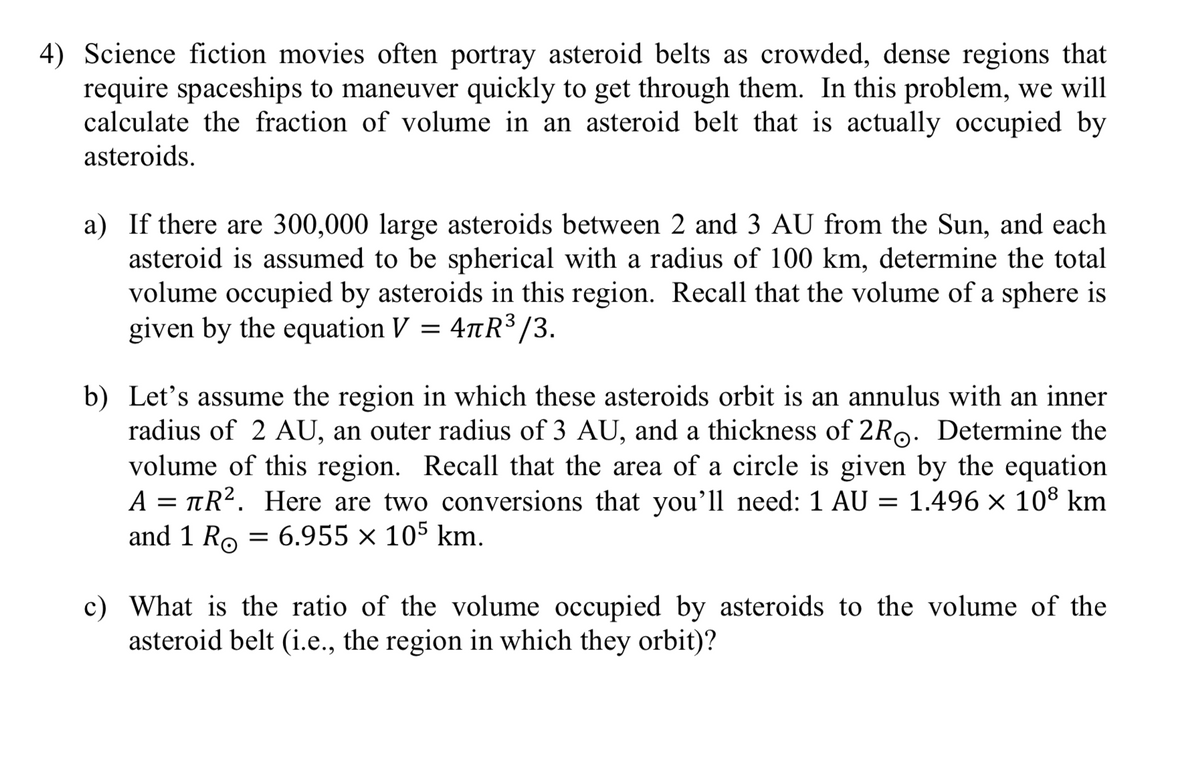) Science fiction movies often portray asteroid belts as crowded, dense regions that require spaceships to maneuver quickly to get through them. In this problem, we will calculate the fraction of volume in an asteroid belt that is actually occupied by asteroids. a) If there are 300,000 large asteroids between 2 and 3 AU from the Sun, and each asteroid is assumed to be spherical with a radius of 100 km, determine the total volume occupied by asteroids in this region. Recall that the volume of a sphere is given by the equation V = 4TR³/3. %3D b) Let's assume the region in which these asteroids orbit is an annulus with an inner radius of 2 AU, an outer radius of 3 AU, and a thickness of 2RO. Determine the volume of this region. Recall that the area of a circle is given by the equation
) Science fiction movies often portray asteroid belts as crowded, dense regions that require spaceships to maneuver quickly to get through them. In this problem, we will calculate the fraction of volume in an asteroid belt that is actually occupied by asteroids. a) If there are 300,000 large asteroids between 2 and 3 AU from the Sun, and each asteroid is assumed to be spherical with a radius of 100 km, determine the total volume occupied by asteroids in this region. Recall that the volume of a sphere is given by the equation V = 4TR³/3. %3D b) Let's assume the region in which these asteroids orbit is an annulus with an inner radius of 2 AU, an outer radius of 3 AU, and a thickness of 2RO. Determine the volume of this region. Recall that the area of a circle is given by the equation
Chapter16: Meteorites, Asteroids, And Comets
Section: Chapter Questions
Problem 1DQ
Related questions
Question

Transcribed Image Text:4) Science fiction movies often portray asteroid belts as crowded, dense regions that
require spaceships to maneuver quickly to get through them. In this problem, we will
calculate the fraction of volume in an asteroid belt that is actually occupied by
asteroids.
a) If there are 300,000 large asteroids between 2 and 3 AU from the Sun, and each
asteroid is assumed to be spherical with a radius of 100 km, determine the total
volume occupied by asteroids in this region. Recall that the volume of a sphere is
given by the equation V = 4TR³ /3.
b) Let's assume the region in which these asteroids orbit is an annulus with an inner
radius of 2 AU, an outer radius of 3 AU, and a thickness of 2Ro. Determine the
volume of this region. Recall that the area of a circle is given by the equation
A = TR². Here are two conversions that you'll need: 1 AU = 1.496 × 108 km
and 1 Ro = 6.955 × 105 km.
c) What is the ratio of the volume occupied by asteroids to the volume of the
asteroid belt (i.e., the region in which they orbit)?
Expert Solution
This question has been solved!
Explore an expertly crafted, step-by-step solution for a thorough understanding of key concepts.
This is a popular solution!
Trending now
This is a popular solution!
Step by step
Solved in 4 steps

Knowledge Booster
Learn more about
Need a deep-dive on the concept behind this application? Look no further. Learn more about this topic, physics and related others by exploring similar questions and additional content below.Recommended textbooks for you


Horizons: Exploring the Universe (MindTap Course …
Physics
ISBN:
9781305960961
Author:
Michael A. Seeds, Dana Backman
Publisher:
Cengage Learning



Horizons: Exploring the Universe (MindTap Course …
Physics
ISBN:
9781305960961
Author:
Michael A. Seeds, Dana Backman
Publisher:
Cengage Learning


Astronomy
Physics
ISBN:
9781938168284
Author:
Andrew Fraknoi; David Morrison; Sidney C. Wolff
Publisher:
OpenStax

An Introduction to Physical Science
Physics
ISBN:
9781305079137
Author:
James Shipman, Jerry D. Wilson, Charles A. Higgins, Omar Torres
Publisher:
Cengage Learning